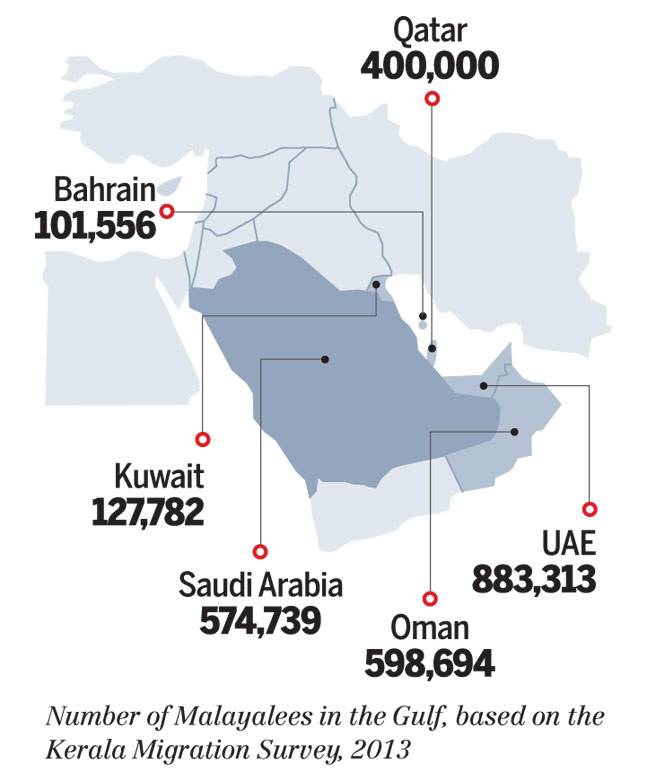Migration: India
This is a collection of articles archived for the excellence of their content. |
HNW individuals’ migration
How The Rich Buy New Nationalities; 2017 figures
How The Rich Buy A New Nationality, July 30, 2018: The Times of India
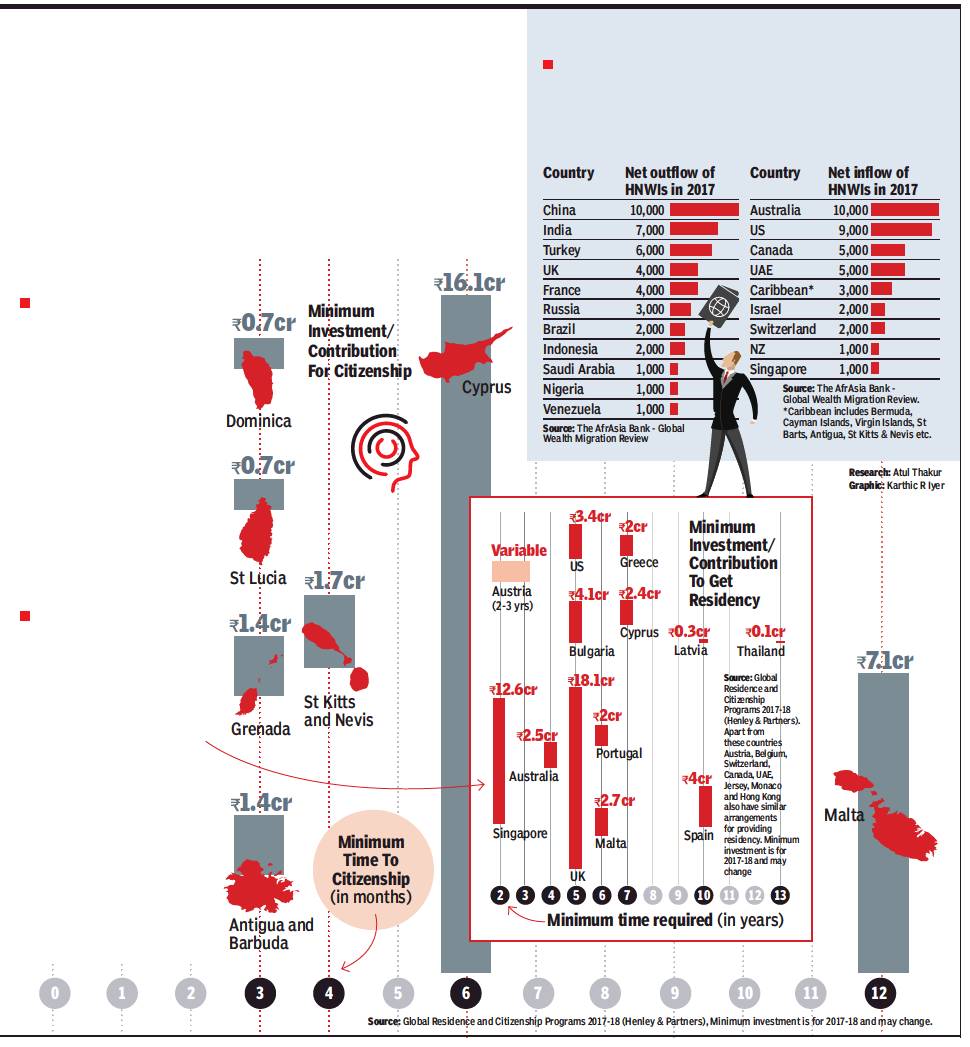
ii) THE countries that they migrate to.
From: How The Rich Buy A New Nationality, July 30, 2018: The Times of India
Fugitive Mehul Choksi bought Antiguan citizenship, and his new passport allows him visa-free entry to over 130 countries. TOI takes a look at how the rich can buy their way to new citizenship and residency
Can citizenship be acquired by investing?
Acquiring citizenship need not be a long-drawn process. Not all nations need you to prove years of residency. Many countries offer the wealthy citizenship-by-investment programmes. This method of granting citizenship was seen as controversial when Caribbean island St Kitts and Nevis pioneered the idea in 1984. But today many countries have followed suit to offer citizenship to well-heeled individuals who donate a fixed amount to the government of their new home or invest over a certain level.
Can permanent residency be acquired by investing?
Many countries that don’t provide citizenship but grant residency to the wealthy if they invest above a certain amount in the local economy. Residency provides unlimited stay and rights enjoyed by locals. These may include benefits like healthcare coverage and the right to work or study. Such residents cannot vote and are not issued passports of their new home nation. Indians, for instance, can apply for Tier 1 (Investor) visa of UK if they are willing to invest GBP 2 million (INR 18.1 cr). Similarly, the process for a US Green Card can be expedited for an individual who invests USD 1 million (or USD 500,000 in rural areas with few jobs) and creates at least 10 new full-time jobs.
Where are the super-rich going and which countries are the biggest losers?
South Africa-based New World Wealth, a global market research group that specialises in wealth statistics, found China followed by India witnessed the highest migration of high net worth individuals (HNWIs) — people with net assets of US$1 million (Rs 6.9cr) or more. The largest recipient of these super rich migrants are Australia, US and Canada.
Immigration (into India)
2010, 2017: Migrants in India

From: February 5, 2019: The Times of India
See graphic:
2010, 2017: Immigrants living in India, China and major countries'
The global position
Religion – wise, 2021

From: March 14, 2025: The Times of India
See graphic:
International Migration, Religion Wise, in 2021
Gulf, Migration to
2013: Malayalis in the Gulf
See graphic:
No. of Malayalees in the Gulf
2014> 2018: Migration to Gulf for jobs drops 62%
Lubna Kably, January 12, 2019: The Times of India
Lubna Kably, UAE is top Gulf workplace for Indians, January 12, 2019: The Times of India
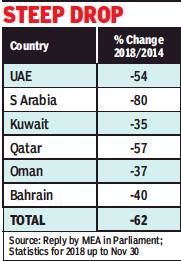
From: Lubna Kably, January 12, 2019: The Times of India

From: Lubna Kably, UAE is top Gulf workplace for Indians, January 12, 2019: The Times of India
The total number of emigration clearances granted to Indians headed to the Gulf, for employment, has dropped by 21% to stand at about 3 lakh during the 11-month period ended November 30, 2018, compared with the year 2017.
Over the past five years, during 2014, the outflow of Indian workers to Gulf was the highest at about 7.8 lakh. Compared with this figure, the decline in 2018 is as high as 62%. These statistics are drawn from the e-Migrate emigration clearance data, which captures the emigration clearances issued to workers holding ECR (emigration check required) passports.
Among all the Gulf nations, the largest outflow of Indian workers in 2018 was to UAE, with about 1 lakh (or 35%) of the total workers being granted emigration clearances. It was followed by Saudi Arabia and Kuwait with 65,000-odd and 52,000-odd workers headed to these countries.
In 2017, Saudi Arabia had relinquished its position as being the most attractive destination among Gulf countries for Indian workers. In its edition dated August 22, 2017, TOI had analysed the Nitaqat scheme for protection of local workers — the decline in expat workers, including from India is attributed to this scheme and the economic conditions.
Qatar stands out by being the only country in the Gulf region, where the number of workers shows an increase in 2018 as compared to the previous year. Nearly 32,500 workers headed to Qatar were granted emigration clearances, as compared to close to 25,000 in 2017, which is a rise of 31%.
“This could be because of increased labour requirement as the country prepares to host the World Cup, 2022” says a Mumbai based labour recruiter. However, there have been some reports of non-payment to Indian workers by unscrupulous employers, an instance of a construction agency not paying nearly 600 workers was recently in the spotlight. Washington headquartered think-tank, The Middle East Institute, says there are an estimated 6 to 7.50 lakh Indian migrant workers in Qatar, constituting the largest expatriate community and nearly double the number of native Qataris.
According to a reply given by the ministry of external affairs in Lok Sabha last December, there are several reasons for the decrease in numbers. “Prominent among them is that the Gulf countries are passing through a period of economic slowdown primarily because of the slump in oil prices.”
Illegal migration
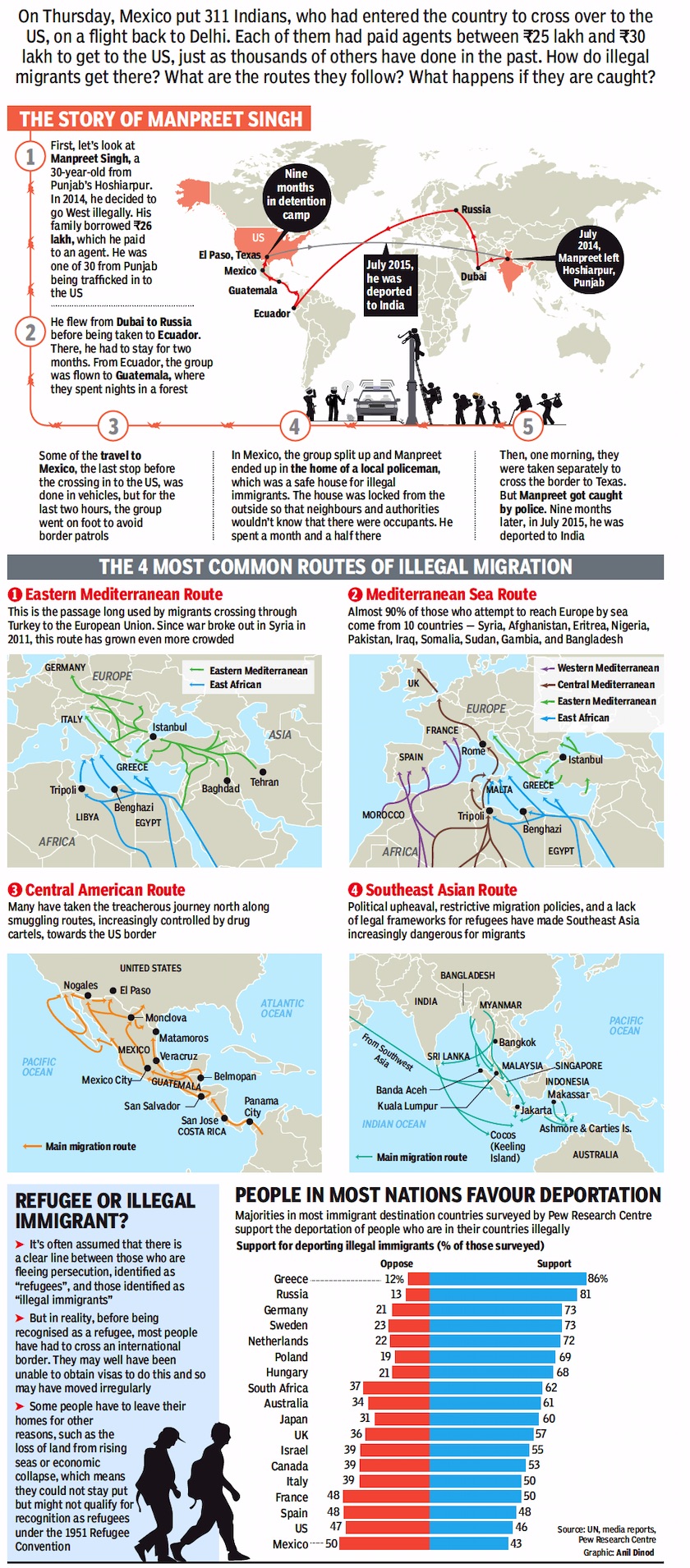
From: Oct 19, 2019: The Times of India
See graphic:
Some of the routes that Illegal Immigrants Take To Go West
Through Mexico
2019: Mexico deports 311 Indians
Oct 18, 2019: The Times of India
In a transatlantic deportation without precedent, Mexico has put 311 Indians caught illegally entering the country and trying to cross over to the US on a Boeing 747-400 charter scheduled to touch down at Delhi airport.
Mexico’s National Migration Institute (INM) said in a release that the deportees, who are being escorted back home by 60 federal migration agents, had been found to have entered the country without valid documents for “regular stay” over the past few months.
The mass deportation revived memories of the tragedy that befell a family from Punjab in June, when a six-year-old girl died of a heat stroke in the Arizona desert on the US-Mexico border after her mother went in search of water during their illegal border crossing. The body of Gurpreet Kaur was found after two Indian women apprehended by US border patrol revealed that a mother and her two children had been with them until a few hours earlier.
Sources said each member of the group possibly paid Rs 25-30 lakh to the agents who arranged their travel to Mexico and promised to help them illegally cross over to the United States.
Trump’s tariff threat on Mexican imports triggered deportation
The cost apparently included airfare, accommodation in Mexico and meals. The agents had purportedly cited a week to a month’s time to arrange their entry into the US, the sources said.
According to the Mexico’s National Migration Institute release, they were caught in Mexico without “papers for regular stay” and produced before immigration authorities in the states of Oaxaca, Baja California, Veracruz, Chiapas, Sonora, Mexico City, Durango and Tabasco. US President Donald Trump’s threat to impose tariffs on all Mexican imports if the country did not put a check on people illegally entering US through the porous borders forced its hand, sources said.
A source said the Boeing 747-400 that took off from Mexico’s Toluca City International Airport with 311 deportees was expected to land in Delhi at 5.45am on Friday.
“This operation was carried out thanks to the excellent communication and coordination with the embassy of that Asian country (Indian) with which the recognition and return of these citizens was worked under strict adherence to the migration law and its regulations,” the INM statement said.
The deportees were issued an “emergency certificate” each, which is a oneway travel document that allows an Indian citizen to enter India in an emergency. Such papers are issued to individuals who lose, damage or have no valid passports.
INM said never before had Mexico carried out a deportation exercise of this scale.
Incomes of migrants
2022: overseas migration raises incomes
April 26, 2023: The Times of India
April 26, 2023: The Times of India
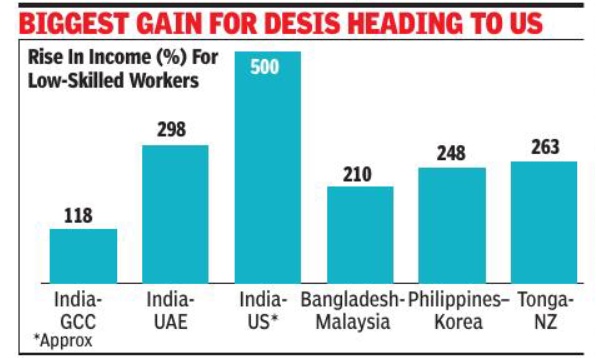
From: April 26, 2023: The Times of India
New Delhi: The World Development Report has estimated a 120% income gain for Indians going to work overseas, compared to a 40% rise in case of internal migration.
The report has estimated that lowskilled Indians migrating to the US stand to gain the most as they would see a jump in income of nearly 500%, followed by UAE at almost 300%.
Those migrating to the Gulf Cooperation Council (GCC) nations, comprising Saudi Arabia, Bahrain, Oman, Qatar, Kuwait and UAE, stand to gain less.
While the gains are much higher for highly skilled workers, like tech workers migrating to Silicon Valley or doctors, even low-skilled workers experience multi-fold jumps. Apart from the skills, the gain also depends on age, destination and language ability.
The report estimated the number of migrants globally at 184 million, which is 2. 3% of the population, including 37 million refugees.
TNN
Details
April 26, 2023: The Times of India
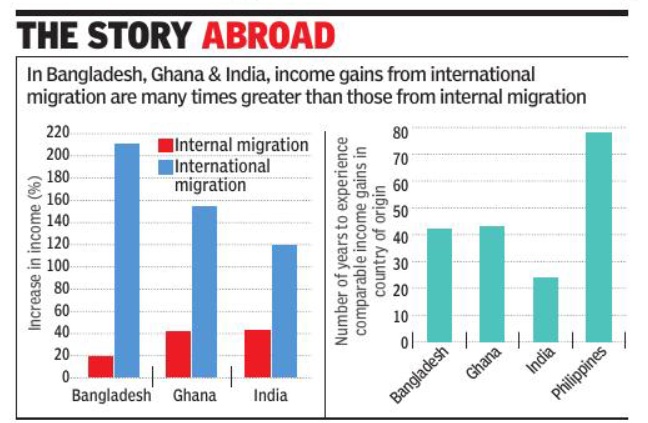
From: April 26, 2023: The Times of India
New Delhi: “Migration leads to large wage increases for most people whose skills and attributes are astrong match with the needs of the destination society. These gains often exceed what could be achieved in the country of origin, even from internal migration to relatively better-off locations. The gains are so large that at current rates of economic growth it would take decades for the average low-skilled person working in some countries of origin to earn the income they achieve by migrating to a high-income country. These gains are then shared with families and communities in the countries of origin through remittances,” said the World Development Report 2023. But migration also comes at a cost, although smaller. For instance, an Indian worker going to Qatar spends two months’ earnings to meet migration cost. It’s a little more for those going to Kuwait. At almost nine months, it is much higher for a Bangladeshi migrating to Kuwait.
It said there are four types of migrants — economic migrants with strong skill match (Indian IT professionals in the US or construction workers in GCC nations), refugees with skills in demand at destination (Syrian entrepreneur refugees in Türkiye), distressed migrants (some poorly skilled migrants at the US southern border) and refugees (Rohingya in Bangladesh).
India-US, India-GCC and Bangladesh-India have been identified to be among the top migration corridors globally along with Mexico-US, China-US, Philippines-US and Kazakhstan-Russia.
It noted how remittances have increased to some of the countries with a large migrant population, including India, Mexico, China and the Philippines. It estimated that an Indian migrant worker in the UAE, for instance, sends nearly 70% of income to the family, with women likely to remit a higher amount. The migration of Indian workers from certain parts of the country has also resulted in internal migration, it said, pointing how emigration from Kerala has resulted in relocation opportunities for workers from Kolkata.
Loans for migration
‘Dollariyo Pradesh’ in north and central Gujarat
Bharat Yagnik & Ashish Chauhan, February 3, 2022: The Times of India
Ahmedabad: Immigrating abroad is not easy, and if you must take a loan to achieve your dream, the process turns into a great burden. Yet, there’s a region in Gujarat where people planning to immigrate legally or even illegally cannot only avail themselves of a loan worth lakhs at 0% interest but also are under no obligation to return the money. While the beneficiaries do not have to pay EMIs, most of them usually pay much more than they received back to the community.
Ankit Patel, 21, from Kalol in Gandhinagar district wanted to go to the US but did not have the financial means to take a loan. He approached a local trust that pooled money from the community to finance youngsters who want to study abroad.
Within a week, the money was arranged. Once Ankit settled down in Pennsylvania, US, he returned double the amount he had taken as a loan back to the trust.
There are various such trusts in the region called ‘Dollariyo Pradesh’ in north and central Gujarat that financially help young men and women to pursue their desire to settle in foreign countries. According to locals, these trusts are informal and mainly run by local communities.
Bhavin Patel (42) is a resident of Dingucha, Gandhinagar, that recently came into the limelight after a family of four from the village froze to death while trying to illegally cross into the US from Canada. He said every family has at least one member in the US, Canada, or Australia. “This doesn’t mean everyone has the money to send their family members abroad. We have a trust in the village which collects money solely for sending people abroad,” said Bhavin.
Migration, outward, to all countries
1990-2019: Afghanistan, Bangladesh, India, Pakistan
Sep 23, 2019: The Times of India
Source: UN Department of Economic and Social Affairs; Graphic: Karthic R Iyer
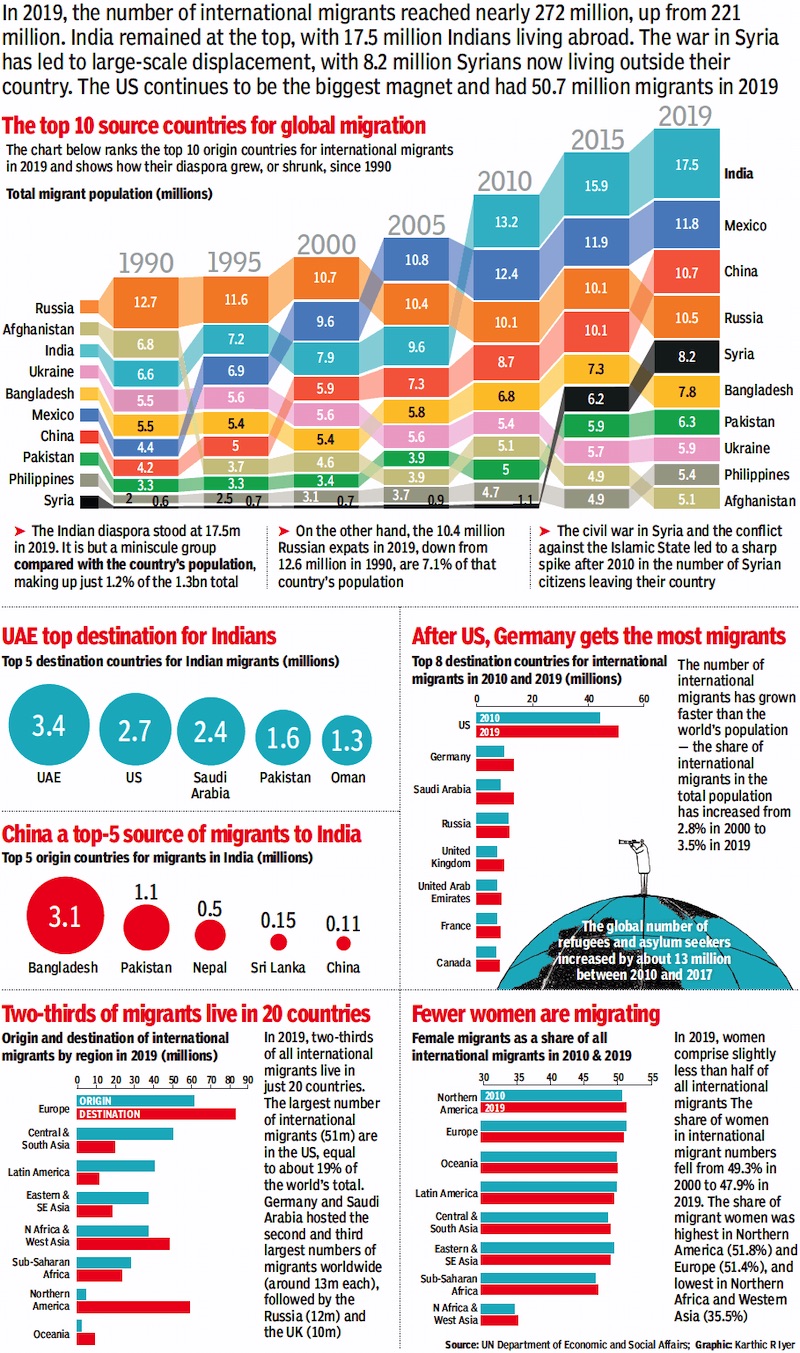
From: Sep 19, 2019: The Times of India
See graphic:
1990-2019: Outward migration from Afghanistan, Bangladesh, China, India, Pakistan and other countries.
In 2019, the number of international migrants reached nearly 272 million, up from 221 million in 2010, an increase of 51 million people or 23%. That's more global migrants than the number of children born each year. India remained at the top, with 17.5 million Indians living abroad.
The US continues to be the main magnet, hosting 50.7 million migrants in 2019, including a sizable and affluent Indian-American community — one of the reasons why US President Donald Trump attended Prime Minister Narendra Modi's 'Howdy Modi' mega rally in Houston, Texas, which witnessed an over 50,000-strong crowd. Not just Trump, other lawmakers — both Republican and Democrat — were also present, a sign that the Indian diaspora's vote in the 2020 US presidential election is important for both sides.
INDIA TOP ORIGIN COUNTRY FOR MIGRATION
But although India ranks at the top with a 17.5 million diaspora worldwide, it is only a minuscule group compared with the country's population, making up just 1.2% of the total 1.3 billion population. On the other hand, the 10.4 million Russian expats in 2019, down from 12.6 million in 1990, are 7.1% of that country's population.
In recent years, Syria has witnessed large-scale displacement owing to the civil war and the conflict against the Islamic State, leading to a sharp spike in migration after 2010 with 8.2 million Syrians now living outside their country.
The chart below ranks the top 10 origin countries for international migrants in 2019 and shows how their diaspora grew, or shrunk, since 1990.
UAE TOP DESTINATION FOR INDIANS
While the US has a large Indian diaspora, it is not the top destination for Indians who want to settle abroad. Gulf countries, particularly the UAE, continue to have a high concentration of Indians, although in recent years they've lost some of their drawing power due to nationalisation programmes, economic recession and the rise in living costs there.
CHINA A TOP-5 SOURCE OF MIGRANTS TO INDIA
India, meanwhile, hosted 5.1 million migrants this year. International migrants as a share of total population remained steady at about 0.4% from 2010 to 2019. China also made it to the top-5 list. But the maximum migrants to India came from Bangladesh. even as concerns over illegal migration from across the India-Bangladesh border persist.
AFTER US, GERMANY GETS THE MOST MIGRANTS
The number of international migrants grew faster than the world’s population in 2019 — the share of international migrants in the total population increased from 2.8% in 2000 to 3.5% this year. The US hosted the largest number of migrants at 51 million, equal to about 19% of the world's total, followed by Germany and Saudi Arabia (13 million each), Russia (12 million) UK (10 million) and UAE (9 million). Three out of every four international migrants are in the 20-64-year age group, a sign that the majority moved countries for better work opportunities.
TWO-THIRDS OF MIGRANTS LIVE IN 20 COUNTRIES
In 2019, two-thirds of all international migrants live in just 20 countries. Europe and North America absorbed the largest share — 82 million migrants live in Europe and 59 million in North America in 2019.
FEWER WOMEN ARE MIGRATING
Women comprised slightly less than half of all international migrants this year. The share of women in international migrant numbers fell from 49.3% in 2000 to 47.9% in 2019. The share of migrant women was highest in Northern America (51.8%) and Europe (51.4%), and lowest in Northern Africa and Western Asia (35.5%).
OECD countries: migation to
2022: From India to OECD countries
Lubna Kably, Nov 15, 2024: The Times of India

From: Lubna Kably, Nov 15, 2024: The Times of India
Mumbai: Each year, Indians continue their journey overseas, with many drawn to rich nations like the US, UK, and Canada — countries within the Organisation of Economic Cooperation and Development (OECD) that have historically opened doors to them. Whether as new immigrants, international students, or those acquiring citizenship, Indians dominate the charts in immigration flows to OECD nations. However, recent protectionist policies hint that the open path may be narrowing.
2022 proved to be a landmark year — a record 5.6 lakh Indians moved to OECD countries — a substantial 35% jump over the previous year. India maintained its lead as the top source of new migrants, with China following at 3.2 lakh. Indians made up 6.4% of all new immigrants to OECD countries, while China contributed 3.8%.
A notable shift was Russia’s rise in the migration ranks. With 2.6 lakh Russians migrating to OECD nations in 2022, Russia surged from 18th place to displace Romania.
The International Migration Outlook 2024, released on Thursday in Paris, detailed these shifts. In 2022, the UK welcomed 1.12 lakh Indians, nearly double the figure from 2021, while 1.25 lakh Indians migrated to the US, marking a 35% increase. Canada, however, saw a dip with 1.18 lakh Indians, an 8% decline from the previous year. In these countries, Indians predominantly migrated through labour pathways, often as principal applicants or as accompanied family members.
China, too, resumed significant migration following two years of Covid-related restrictions. In 2022, over three lakh Chinese immigrants to OECD member countries, up 13% from the previous year. Particularly in the US, migration flows from China jumped by 37%, returning to pre-pandemic levels with 68,000 new arrivals.
Russia and Romania, which contributed 2.7 lakh new immigrants each, were the next top origin countries. Meanwhile, Türkiye, Israel, and Germany emerged as the primary OECD destinations for Russian migrants. Romanians, on the other hand, largely headed to Germany, Spain, and Italy.
Yet, the welcome for new immigrants is visibly less enthusiastic. Under the incoming Trump administration, immigration to the US may face tighter scrutiny, including on work visas. Canada, too, recently announced a planned cut in immigration targets for the next three years, and the UK has introduced protectionist policies, such as raising wage thresholds and reducing the list of shortage occupations.
Citizenship Trends: In 2022, over 1.9 lakh Indians took the nationality of an OECD country, marking a 40% increase and securing India’s place as the top origin country for new OECD citizens. This record was largely driven by a threefold increase in Indians acquiring Canadian citizenship, totalling 60,000. The report anticipates a further rise in 2023.
Syria ranked second in 2022, with 1.34 lakh nationals gaining OECD citizenship—a 28% increase from 2021—followed by Morocco, with 1.21 lakh Moroccan nationals becoming citizens in Spain, Italy, and France. Mexicans largely acquired American citizenship, in 2022 their numbers dipped slightly.
Outward migration from India
2011 – 2022
Shyamlal Yadav, June 28, 2023: The Indian Express
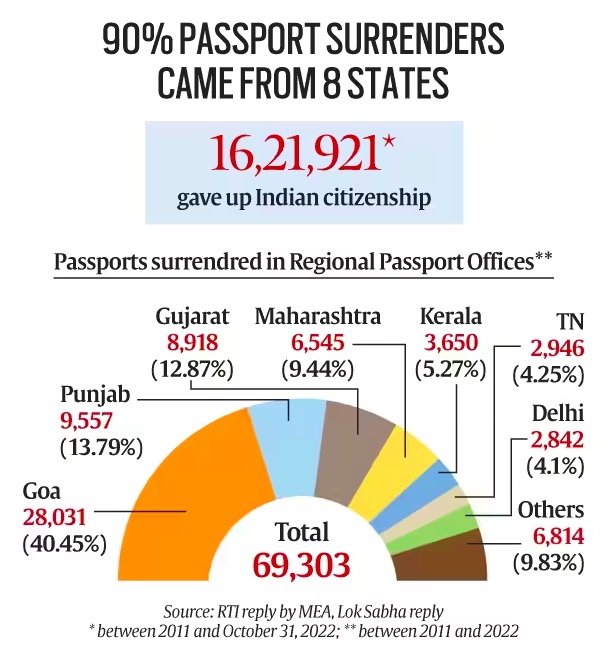
From: Shyamlal Yadav, June 28, 2023: The Indian Express
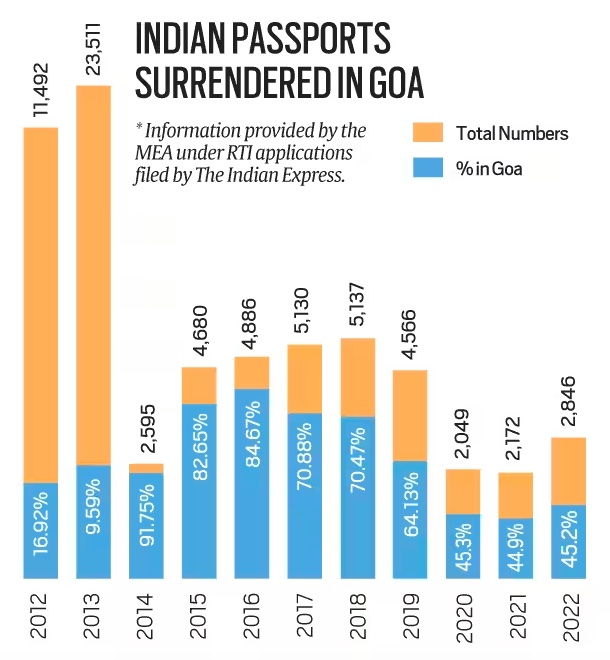
From: Shyamlal Yadav, June 28, 2023: The Indian Express
The information provided covers passports surrendered at RPOs. The numbers shot up in 2012 & 2013 before settling in the 2000-4000 range over the next nine years.
Between 2011 and 2022, close to 70,000 Indians surrendered their passports at regional passport offices (RPOs) across the country, with eight states – Goa, Punjab, Gujarat, Maharashtra, Kerala, Tamil Nadu, Delhi and Chandigarh – accounting for over 90 per cent of the surrendered documents.
As many as 40.45 per cent of the 69,303 passports that were given up in this period were surrendered at the RPO in Goa, reveals data shared by the Ministry of External Affairs (MEA) in response to a Right to Information (RTI) application filed by The Indian Express.
The 69,303 passports surrendered in RPOs since 2011 are, however, only a fraction of the Indian citizenship that was renounced in this period. According to information shared in Parliament by Minister of State in the MEA V Muraleedharan on March 24 this year, between 2011 and October 31 last year, over 16.21 lakh Indians renounced their citizenship.
The information provided under the RTI Act only covers passports surrendered at RPOs, not the ones relinquished at Indian embassies and High Commissions abroad.
The RTI data, which offers a glimpse of the traffic outflow from the country, was shared on an order from the Central Information Commission on a second appeal.
Under The Indian Citizenship Act, 1955, Persons of Indian Origin are not allowed dual citizenship. If a person has ever held an Indian passport and has obtained the passport of another country, they are required to immediately surrender their Indian passport.
Of the 69,303 passports surrendered, Goa accounted for the highest number – 28,031, or 40.45 per cent – followed by Punjab (including the UT of Chandigarh) where 9,557 passports (13.79 per cent) were surrendered at the RPOs in Amritsar, Jalandhar and Chandigarh.
Gujarat stood third on the list, with 8,918 passports (12.87 per cent) being surrendered at RPOs in Ahmedabad and Surat between 2011 and 2022. In Maharashtra, 6,545 passports (9.44 per cent) were surrendered at RPOs in Nagpur, Pune and Mumbai/Thane.
The southern states of Kerala (3,650 surrendered passports, 5.27 per cent) and Tamil Nadu (2,946 surrendered passports, 4.25 per cent) also featured on the list of states where a substantial number of people relinquished their passport.] The MEA data presented in the Lok Sabha shows that on an average, 11,422 Indians renounced their Indian citizenship every month since 2011. On the other hand, 482 Indian passports were surrendered on an average every month during this period at RPOs across India.
A year-wise analysis of the passports surrendered at RPOs in India shows that only 239 passports were surrendered in 2011, but over the next two years, the numbers shot up – 11,492 in 2012 and 23,511 in 2013 – before settling in the 2,000-4,000 range over the next nine years (see box).
Goa has consistently topped the list of states with the highest number of surrendered passports, except for 2012 and 2013, when Gujarat had the maximum numbers. In 2014, the passports surrendered in Goa’s RPO accounted for over 90 per cent of the total surrendered across the country (see box).
Portugal offers those born in Goa before 1961 – the year that marks Goa’s liberation from Portugal – and two future generations the option of registering as Portuguese citizens. A Portuguese passport provides the holder visa-free entry to several countries, including the UK and EU. Portugal has been a member of the EU since 1986.
State-wise/ destination-wise: 2011-22
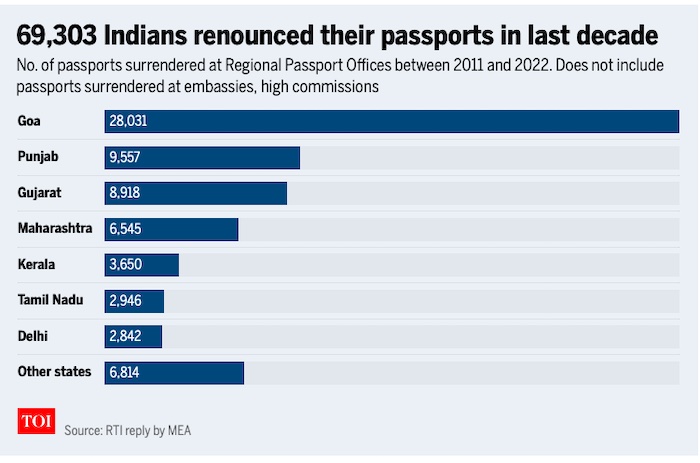
From: Vivek Menezes, July 5, 2023: The Times of India
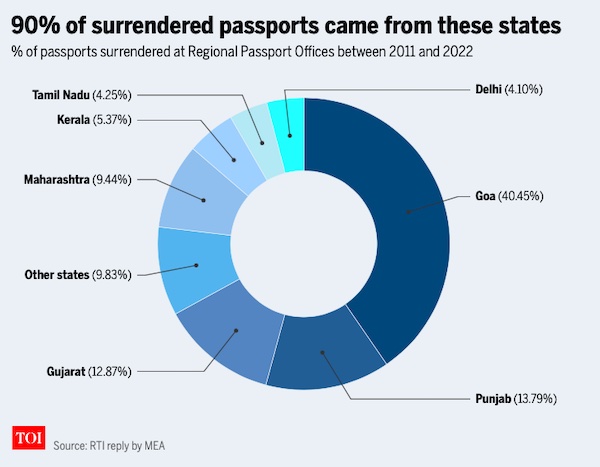
From: Vivek Menezes, July 5, 2023: The Times of India
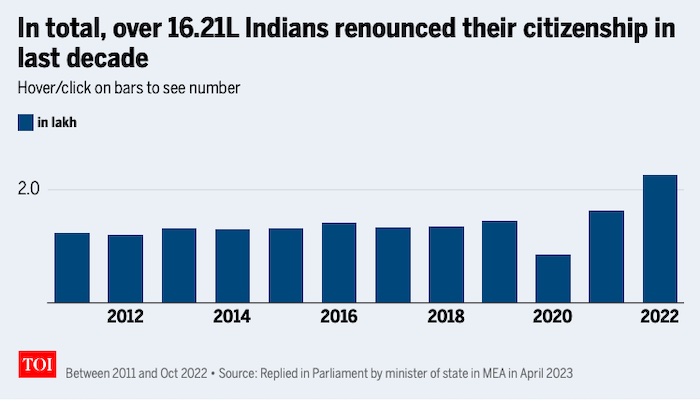
From: Vivek Menezes, July 5, 2023: The Times of India
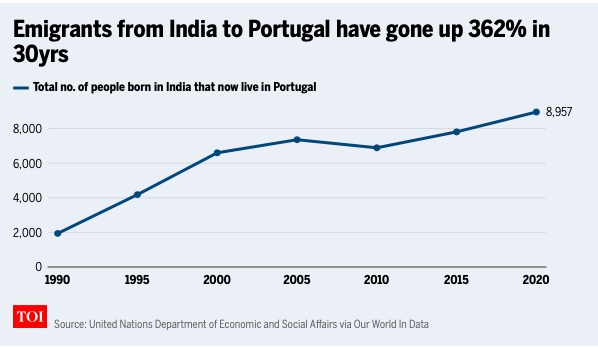
From: Vivek Menezes, July 5, 2023: The Times of India
See graphics:
No. of passports surrendered at Regional Passport Offices, 2011-22
% of passports surrendered at Regional Passport Offices between 2011-22, state-wise
Indians renouncing citizenship, 2012-22
Total no. of people born in India that now live in Portugal, 1990- 2020
2017, 2018: to OECD countries
Lubna Kably, October 20, 2020: The Times of India
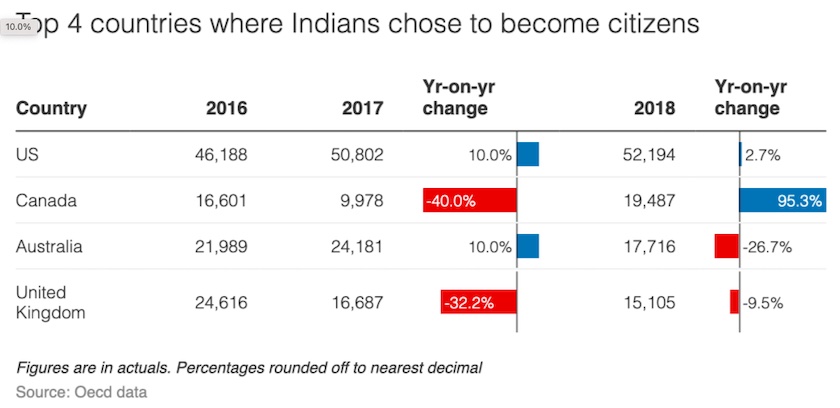
From: Lubna Kably, October 20, 2020: The Times of India
India world No. 2 in migrations to OECD nations, getting citizenships
MUMBAI: India has emerged as the second largest source country both in terms of the “total” inflow of new migrants to OECD countries during 2018 and also as regards the number of Indians acquiring citizenship of these countries. While China continued to retain its top slot as the largest source country, India replaced Romania to emerge as the second largest source. During 2018, about 4.3 lakh Chinese migrated to OECD countries, accounting for nearly 6.5% of the total migration inflows.
However, there was a slight decline of 1% as compared to the previous year. On the other hand, migration from India to OECD countries increased sharply by 10% and reached 3.3 lakh. Migration from India represents about 5% of the overall migration to OECD countries. While Canada saw a huge spike in numbers, others such as Germany and Italy also saw more arrivals as compared to the previous year.
Collation of country-wise data shows that the “total” inflow of new migrants to OECD countries was 66 lakh, a slight rise of 3.8% over the previous year. Data on migra tion flows by nationality may include temporary migration for some destination countries, clarifies OECD. The Organisation for Economic Co-operation and Development is an association of 37 member countries, such as European countries, US, Canada, Australia, New Zealand, and Japan.
As these are well-developed economies, they attract a large share of immigrants, be it for work, studies or even asylum. Before the pandemic, permanent migration flows to OECD countries (bar Colombia and Turkey that have hosted a large number of humanitarian migrants in recent years) was 53 lakh in 2019, with similar figures for 2017 and 2018. Permanent migration flows do not include temporary labour migration or international students.
While releasing the “International Migration Outlook 2020” at a virtual press conference on Monday, Angel Gurría, secretary general at OECD, said Covid-19 has redrawn the international mi gration map. Following the onset of Covid-19, almost all OECD countries restricted admission to foreigners. Issuances of new visas in these countries plummeted by 46% in first half of 2020 compared with the same period in 2019. This is the largest drop ever recorded. In the second quarter, the decline was 72%. The secretary general said migration would continue to play a key role for economic growth and innovation, and in responding to rapidly changing labour markets.
2015-16: Educated migrants
November 28, 2020: The Times of India
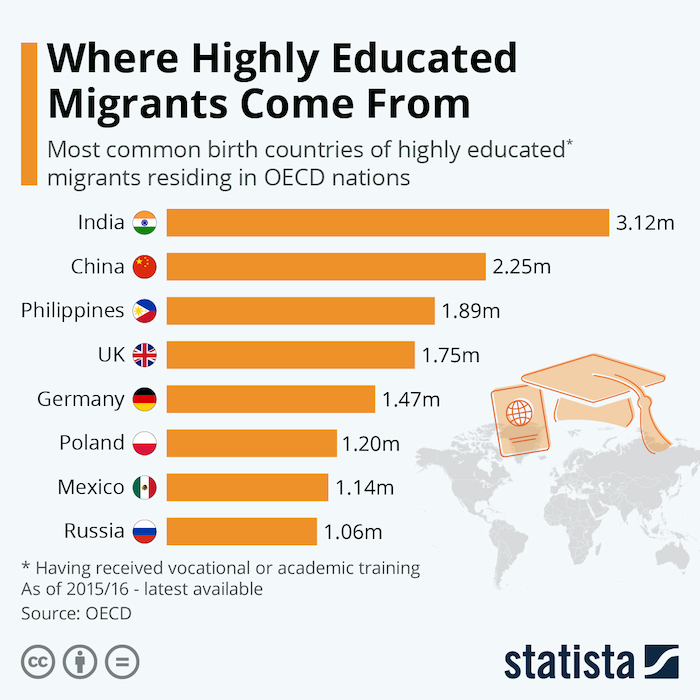
From: November 28, 2020: The Times of India
Indians top the list of educated migrants in rich countries OECD data reveals that there are around 120 million migrants living in OECD member countries. 30 to 35 percent of these migrants are considered highly educated, meaning they have received vocational or academic training. Among the most common birth countries for highly educated migrants, these shares are a lot higher, however.
For India, which topped the list as of 2015/16 with more than three million highly educated migrants in the OECD, the share of those considered of high education status was nearly 65 per cent. China had a rate of 48.6 percent highly educated migrants in the OECD – or 2.25 million.
The Philippines come in rank 3, behind the world’s two biggest countries and ahead of a list of OECD nations, naturally trading highly educated personnel back and forth with each other, especially within Europe. 53.3 percent of Filipino immigrants to the OECD are considered highly educated, which brings the total to almost 1.9 million for a country of just over 100 million inhabitants. In a paper on the Philippines, the International Labor Organization finds that many of those high skilled migrants - to OECD countries and elsewhere – were health care professionals, especially nurses. Because of the coronavirus pandemic, the Philippines government has put a stop to this brain drain at least temporarily by capping the deployment of newly hired nurses at 5,000 per year.
Around half of Filipino migrants in the OECD chose the United States, forming one of the most important migration corridors identified by the OECD, behind Mexican and Indian immigration to the United States and ahead of Polish immigration to Germany.
2017-21: Rich people, and others
Sunainaa Chadha, March 25, 2022: The Times of India
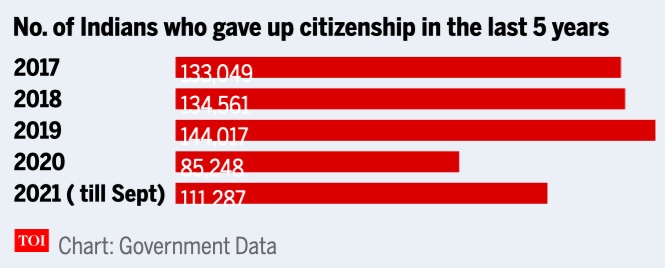
From: Sunainaa Chadha, March 25, 2022: The Times of India
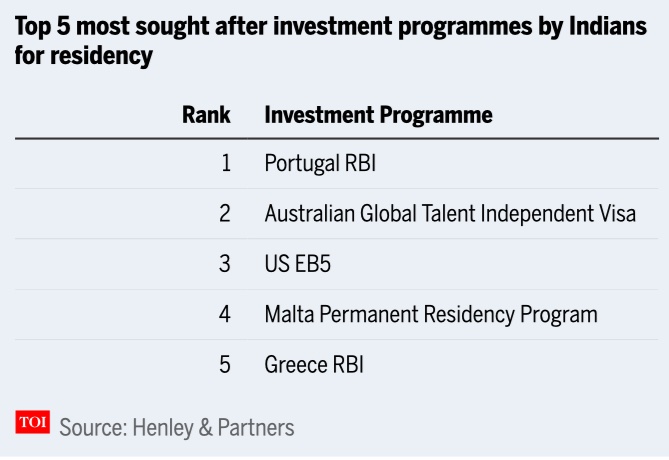
From: Sunainaa Chadha, March 25, 2022: The Times of India
Indian nationals topped the charts for enquiries received by the firm in 2021 by a significant margin, with growth of 54% compared to 2020 — a year which itself saw a 63% rise in interest shown by Indian investors.
NEW DELHI: Ultra-high net worth individuals from India, the US and UK accounted for the bulk of investment migration inquiries in 2021, according to a report by residence and citizenship planning company Henley & Partners.
Indians accounted for the highest number of investment migration inquiries in 2021 and queries within this group surged 54 per cent annually.
Investment migration refers to wealthy investors acquiring alternative residence or additional citizenship in exchange for a substantial contribution to the host country.
Over six lakh Indians have given up their citizenship in the last five years, according to data by the ministry of external affairs, 40% of them being in the US. The overall number also included those availing a golden visa - where you invest in countries like, say Portugal, Malta or Cyprus in return for residence or citizenship.
Around 1,44,017 people gave up their Indian citizenship in 2019, which has been the highest in the last five years. The lowest was in 2020 at 85,248, and this is probably because of the Covid-19 pandemic. At 11,287 2021 saw the steepest spike in Indians giving up their citizenship as worldwide travel and outdoor restrictions started to ease. Point to note: Data for 2021 is only available till September 2021.
Statistics from the Global Wealth Migration Review show that 2% of India’s millionaires had already flocked overseas in 2020. While China topped the migration list with a total of 16,000 High Networth Individuals exits, India came in second at 7,000 exits, and Russia 5,500 exits.
So, where do India's super rich want to migrate to?
While Portugal tops the list, Malta and Greece also appear in the top 5 countries, Indians wants to move to.
“While India remains an exceptionally exciting place for business activities, commercial growth for corporations, and high-yielding investments, high-net-worth families are becoming increasingly cosmopolitan and transnational and are keen to diversify a portion of their wealth abroad. Families are seeing the benefits of investment migration not only as a means to improve their mobility, or for lifestyle and education purposes, but also as an avenue to access global markets, to protect their families’ futures, and to have an insurance policy in place to diversify their domiciles as a hedge in this volatile world in which we live." explained Nirbhay Handa, Group Head of Business Development at Henley & Partners.
Up until a few years ago, India’s investment migration market was largely geared toward the US EB-5 programme but now a lot of European countries including Spain, Portugal and Malta are increasingly being looked at as places to own retirement or holiday homes, places to do conduct business and enjoy lifestyle benefits. Alternative residence has become a legitimate wealth management tool today since it is the primary determinant of any macro stimuli to one’s business or wealth preservation initiatives.
"In the world of investments, it is considered best practice to invest in different regions and asset classes, from equities to real estate, to spread the risk and find the greatest value. But what about where you reside? The same principle applies. The more jurisdictions you can access, the more diversified your assets and opportunities, and the lower your exposure to country‐specific risks," added Handa.
Not just India's rich but several start-up entrepreneurs are also keen on multiple residencies offered either through structured residency investment programmes in Portugal or Malta or through setting up businesses in countries like the UAE or talent-based visas offered by Australia and Singapore.
But why Portugal?
Portugal is the number one choice for those opting for the structured residency programme.
With a minimum investment of EUR 280,000 in real estate, the Portugal Golden Residence Permit Program is one of Europe’s most popular residence programmes, giving successful applicants the right to live, work and study in Portugal as well as visa-free travel in the European Schengen area. With that also comes the possibility of applying for citizenship after five years.
The program is seen as a relatively easier way to gain alternative residency in Portugal, especially because of its low physical presence requirement (investors are only required to live in Portugal for 7 to 14 days a year). The application approval process is also quicker, and usually takes just a year.
"With high scores for its low investment amount, saleability, and crypto-friendliness, investing in real estate in this EU member state is a wise move that many global investors, have already made," said Henley & Partners in a report.
However, earlier this year the rules were tweaked slightly. While the minimum amount for investment in real estate doesn't change, purchasing residential property in the coastal cities of Lisbon, Porto, and the southernmost region of Algarve which were prime real estate hotspots, is no longer an option because of burgeoning property rates in these popular scenic destinations, as well as to redirect investment to the low-density areas of the country.
". Commercial property investments may still be allowed in these coastal regions. We anticipate historical centers to become more attractive for individuals interested in applying for PGV through the residential property purchase route, as well as regions such as Alta de Lisboa, Marvilla, Campanha, Almada, Loures, Vila Nova de Gaia and Maia," said Shilpa Menon, Senior Director India- LCR Capital Partners.
LCR Capital Partners expects private equity / VC fund routes through the Portugal Golden Visa will become more popular, accounting for a larger share of applications going forward.
"In the case of the private equity/VC funds, the investment amount has increased by 50% from EUR350,000 to EUR500,000. However, sophisticated investors often prefer this option as it is a regulated, hassle-free and tax efficient way to attain the PGV that also provides the opportunity to realize a good return on their capital at the end of the 5-7 year investment period," said Menon.
Data from Strokes and Ground Unipessoal LDA, a realty developer based in Portugal, shows that even with the rule for an increase in the minimum investment for VC Funds, the share of funds as an asset class has increased from 9% in 2021 to 14% in 2022 till date already.
What's so great about Malta?
The Malta Permanent Residence Program grants qualified applicants a Maltese Residence Permit, which offers visa-free access to Europe’s Schengen Area. The minimum contribution is EUR 175,000 for mixed capital requirements.
Malta has a diversified economy comprising of industries such as IT, Manufacturing and Gaming. The country also provides a high standard of living at an affordable cost with an English-speaking environment, which is a major draw for international residents. Moreover, the island's location between Europe, North Africa and Middle east is very attractive for entrepreneurs.
"Portugal Golden Visa has always been an attractive alternative residency program but Malta’ Permanent Residence Program which is recently structured is now starting to gain more traction as well. It is likely that families will compare both options before they make a decision on one. The capital threshold to qualify for Malta Permanent Residence is lower compared to Portugal Golden Visa which also makes it attractive," said Handa.
Other sought-after options
The Greece Golden Visa Program provides not just fast-tracked residency in the country, but successful applicants and their families are also able to benefit from visa-free access to Europe’s Schengen Area, subsidized healthcare and public education in Greece within two months of applying. They would need to invest in real estate valued at a minimum of EUR 250,000.
The EB-5 Visa is a US visa created by the Immigration Act of 1990 for obtaining a Green Card for foreign investors and their family (spouse and dependents under the age of 21) willing to make a significant investment in the US. The purpose of the EB-5 Visa is to stimulate the US economy through job creation and capital investment by offering foreign immigrant investors all of the benefits of permanent residency in the US. The minimum investment requirement has been raised to 800K USD in Targeted Employment Areas ( TEAs)
Australia’s Global Talent visa is a fast-tracked visa program with a streamlined path to permanent residence for talented individuals. It has been designed to grow Australia’s innovation and tech economies in a bid to boost economic recovery, enhance resilience, and drive competitiveness by attracting dynamic, highly skilled individuals to relocate to its safe shores. India is among the top countries showing interest in the Global Talent visa program along with the UK and the US, according to statistics from the Australian Department of Home Affairs.
Successful applicants are able to obtain fast-tracked permanent residence for the whole family within six weeks, which makes the program extremely appealing and which will ultimately drive demand for real estate. There’s no investment required for this visa, only application, processing and other related fees.
What are the benefits of holding a golden visa?
A golden visa provides families with access to new markets and a host of business, career, educational, healthcare, tax, and lifestyle opportunities on a worldwide scale, for both present and future generations.
Many golden visa programs allow the successful applicant to apply for citizenship after a few years of residence, such as the Portugal Golden Residence Permit Program, which offers citizenship eligibility after five years.
The Greece Golden Visa Program allows investors to apply for citizenship after seven years, and the Italy Residence by Investment Program after 10 years.
"Providing increased optionality worldwide along with the ability to hedge against potential risk and volatility, golden visas allow HNWIs and their families to secure an alternative safe haven, enrich and expand their lifestyle and business opportunities, enjoy a high quality of life and access to excellent infrastructure, access world-class healthcare at leading facilities and attend first-rate educational institutions," said Henley and Partners.
The purchase or lease of real estate is a key driver and requirement of residence by investment programs, with popular EU destinations including Cyprus, Greece, Malta, and Portugal. Real estate–linked golden visa programs have the additional advantage of enhancing one’s options for relocation or retirement (or both).
2022-23
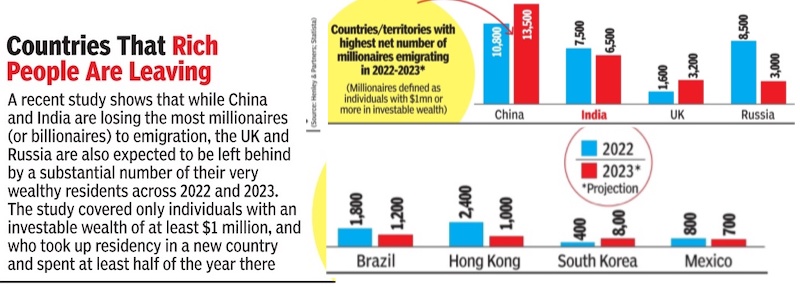
From: June 23, 2023: The Times of India
See graphic:
The immigration of millionaires from China India and comparable countries in 2022 – 2023
OECD: 2019 21
Oct 24, 2023: The Times of India
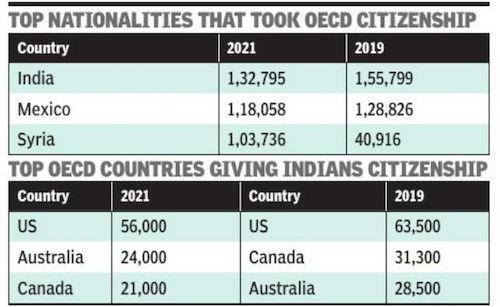
The OECD countries that gave the largest number of Indians citizenship
2019 – 21
From: Oct 24, 2023: The Times of India
The figure for 2019 was around 1.5 lakh. China came in fifth in this race in 2021. Around 57,000 Chinese nationals acquired OECD country citizenships that year.
The top three countries in the 38-member OECD that handed out passports to Indian immigrants in 2021 are the US (56,000), Australia (24,000) and Canada (21,000). In 2019, the US was the top favourite, with 63,500 Indians acquiring its citizenship, followed by Canada (31,300) and Australia (28,500). OECD country citizenships for 28 lakh foreign nationals represent a sharp departure from the relatively stable figures registered since 2010, which were in the range of 18 lakh and 22 lakh. Canada’s 174% jump meant 3.75 lakh new citizens were admitted during 2022. The US, a much bigger country by population, saw 9.7 lakh foreign nationals acquiring its citizenship during 2022, but in percentage terms it was a rise of 19% only over the previous year.
Mexicans follow Indians in the OECD citizenship stakes. During 2021, around 1.2 lakh Mexicans acquired citizenship, largely in the US. In that year, Philippines and China were replaced by Syria and Morocco as third and fourth countries of origin, respectively, of new citizens in OECD member countries.
Indians No. 1 in obtaining citizenship of rich nations
Canada Sees Biggest Jump In Offering Passport To Fgn Nationals
Delhi and Ottawa may be locked in a diplomatic stand-off. But when it comes to immigration, they are in a jugalbandi. Indians, who top the charts in migrating to OECD countries, also lead in acquiring foreign citizenship (with American citizenship continuing to dominate). Canada has shown the steepest growth in granting citizenship to foreign nationals.
Per an OECD report released in Paris — International Migration Outlook:2023 — In dians form the largest national group when it comes to acquiring rich-country citizenship and Canada registered the biggest proportionate increase — a 174% jump between 2021 and 2022 — among host countries offering their passports to foreign nationals.
Last year also saw the highest number of foreign nationals acquiring OECD country citizenship: 28 lakh, a 25% jump over 2021. The report does not provide detailed breakup of country-of-origin data for 2022. But it says India has been the main country of origin when it comes to acquiring OECD country citizenships since 2019.
In 2021, around 1.3 lakh Indians acquired citizenship of an OECD member country.
2021: to OECD countries
Lubna Kably, Oct 11, 2022: The Times of India
A record 23 lakh foreign nationals acquired citizenship in OECD-member countries in 2021, based on preliminary and partial data, according to the International Migration Outlook — 2022 Report, which was released in Paris.
It is a 20% increase over the previous year, when the citizenship acquisition stood at 19 lakh. The reason behind this is partly due to a reduction in the backlogs of citizenship applications during the Covid-19 pandemic. A big jump was registered in citizenship numbers in the US, the UK, Canada, Norway and Austria. In 2019, before thepandemic caused havoc, the citizenship acquisition numbers in OECD-member countries had stood at 22 lakh.
Source-country wise figures are not available for 2021. However, Indians continued to remain in the first position in 2020. Over 1. 3 lakh Indians acquired citizenship of OECD-member countries —over half of which were concentrated in the US (47,000), Canada (15,000) and the UK (11,000). Nearly 88,745 Mexicans acquired overseas citizenship — largely of the US.
In 2019, 1. 6 lakh Indians obtained citizenship of OECDmember countries. Naturalisation of Indians in the US was (63,500), Canada (31,300), Australia (28,500) and the UK (14,700). A comparison between the statistics of 2019 and 2020 shows a decline in the number of Indians acquiring foreign citizenship, as the pandemic put on hold processing of citizenship applications and oath ceremonies. The country-wise figures for 2021, when released will show the exact rebound.
Details
Lubna Kably, Oct 24, 2023: The Times of India
Mumbai : China has the largest number (stock) of international students in OECD-member countries, whereas India tops the charts in terms of ‘flow’ of new migrants, according to the report ‘International Migration Outlook: 2023’.
Organisation for Economic Co-operation and Development (OECD) is an association of 38 member countries, most of them being rich-developed nations; understandably it attracts migrant workers and students.
During 2021, for the second consecutive year, India with an outflow of 4 lakh new migrants (students excluded) to OECD-member countries was the top country of origin, constituting 7.5% share of total flows. However, this was a miniscule rise of 3% as compared to the 2019 figure. The flows during 2020 were low at 2.2 lakh, but this can be attributed to closed borders during the pandemic. China at second position was far behind with 2.3 lakh new migrants (or 5.2% of the total flows), followed by Romania with 2 lakh odd new migrants (or 4% of the total flows).
Mobility agreements entered into with India found a mention in the report. “To step up efforts to actively recruit immigrant workers, several OECD-member countries continue to sign bilateral agreements and advance migration and mobility partnerships with selected origin countries. Portugal, Germany and Austria have recently concluded agreements on migration and mobility with India. This is the first time Germany has signed such a bilateral agreement, and the agreement is intended to serve as a model for potential future similar agreements with other countries,” it stated. It also mentioned that India has previously concluded bilateral migration and mobility agreements with Finland, France and the UK. In the backdrop of the Ukrainian crisis, the new migrant flows could see a new picture emerging. As of June 2023, there were around 4.7 million displaced Ukrainians in OECD-member countries.
OECD-member countries stand to gain with the steady influx of international students, largely from China and India. In 2021, 43 lakh international students were enrolled in OECDmember countries, and China dominated with a stock of 8.9 lakh students. Indian students stood at 4.2 lakh during 2021, an almost static figure as compared to 2020. Vietnam was the third ranked source-country with 1.3 lakh students. Almost one-fifth of international students in OECD are hosted by US, which housed 8 lakh odd international students; UK hosted 14% (or 6lakh) of all international students, followed by Australia (9%) with 3.8 lakh students.
Kerala
2023
Shaju Philip, June 15, 2024: The Indian Express
The global Malayali diaspora is estimated to be 5 million, whereas the Malayali diaspora outside Kerala but within India is estimated at 3 million. (Express Photo)
Significant rise in student migration, indications of saturation in international migration, increase in the number of returning emigrants, growth in female emigration and surge in remittance to Kerala after the Covid-19 pandemic are some of the highlights of the Kerala Migration Survey (KMS) 2023.
The report of the KMS-2023, by the International Institute of Migration and Development (IIMAD)-Thiruvananthapuram, was presented Friday at the Loka Kerala Sabha, an event hosted by the state government of Kerala to bring Malayali diaspora living around the globe.
The study said the number of emigrants from Kerala is estimated to be 2.2 million, closely aligning with the 2.1 million recorded in the KMS 2018. This stability in international migration over the last five years is interesting given the overall declining trend observed over the past decade in the previous rounds of KMS.
The global Malayali diaspora is estimated to be 5 million, whereas the Malayali diaspora outside Kerala but within India is estimated at 3 million.
Although there is a slight increase of 32,388 emigrants in 2023, 9 out of the 14 districts in Kerala observed a considerable decline in the number of emigrants when compared to 2018, indicating a saturation of international migration. Despite expectations of a further decline in this round of KMS, a significant rise in student emigration has substantially contributed to maintaining emigration levels.
The survey said the number of student emigrations has doubled from 129,763 in 2018 to about 250,000 in 2023. “This notable increase in student emigration underscores a significant shift in the demographics of emigrants from Kerala, wherein there has been an increase in the number of emigrants leaving at a very young age, as early as 17 years,” said the report.
The KMS 2023 shows that students constitute 11.3 percent of total emigrants from Kerala, indicating that a growing number of younger individuals are choosing to emigrate, particularly for education abroad.
The proportion of female emigrants increased from 15.8 per cent in 2018 to 19.1 per cent in 2023. Female migration has further seen a shift from GCC countries to Europe and other Western nations as destination countries, accounting for 40.5 per cent.
The number of emigrants who have returned home is estimated to be 1.8 million, a significant increase from 1.2 million in 2018. This increase over the last few years had been expected due to the global health crisis-induced economic disruptions, stricter immigration policies, and a significant reduction in available job opportunities.
According to KMS 2023, the total remittances to Kerala saw a significant surge after the pandemic, touching Rs 2,16,893 crore in 2023 from Rs 85,092 crore in 2018 — a 154.9 per cent increase. While remittances to Kerala have been increasing over the years, the number of households receiving them has declined from 16 percent of households in 2018, to 12 percent in 2023.
North Kerala remains a focal point for migration. North Kerala district Malappuram was the origin of nearly 377,647 emigrants in 2023. With regards to the religious distribution of the emigrants from Kerala, Muslims lead at 41.9 percent, followed by Hindus at 35.2 percent and Christians at 22.3 percent. The Gulf Cooperation Council (GCC) countries remain the strongest corridor with regard to the destination of migration.
Incidentally, Kollam district surpassed Malappuram this year in terms of household remittances. Kollam received 17.8 per cent compared to Malappuram’s 16.2 per cent. Similar to the previous years, Muslim households continued to receive the highest share of remittances, accounting for 40.1 per cent, followed by Hindu households at 39.1 per cent, and Christian households at 20.8 per cent.
Of the 20,000 households surveyed, 16.2 per cent reported having at least one emigrant — a slight decrease from the 17.3 per cent reported in 2018. However, in 2023, the total number of non-resident Keralites — including both emigrants and return emigrants — is estimated to be 4 million, an increase from 3.41 million recorded in 2018.
Two out of five households in Kerala were found to have non-resident Keralites, indicating the significant presence of migration experiences within the economy and society.
During the KMS 2023 data collection, many homes were found to be locked because entire families had migrated. About 4.2 lakh cases of family migration have been identified as part of the survey.
The United States of America
Unauthorised migration: 2019-2022
Ashish Chauhan, March 13, 2025: The Times of India

From: Ashish Chauhan, March 13, 2025: The Times of India
A new study titled ‘Unauthorized Indians in the United States: Trends and Developments’ highlights the complex dynamics of illegal Indian immigration to the US, revealing sharp differences between Gujaratis and Punjabis. The research, conducted by Abby Budiman, a PhD candidate, and Devesh Kapur, a professor at Johns Hopkins University’s School of Advanced International Studies, identifies significant disparities in asylum outcomes based on regional origin.
As mentioned in the study, according to data from the 2019-2022 American Community Survey (ACS) — covering all foreign-born Indians in the US — Gujaratis report higher average income compared to Punjabis. However, Punjabis have significantly better chances of securing asylum. This disparity, researchers suggest, reflects the economic backgrounds of these immigrants and the narratives they present to US authorities. The study reveals that the average personal earnings of Gujaratis in the US stood at $58,000, compared to $48,000 for Punjabis. However, Gujarati speakers still record the second lowest personal earnings after Punjabi speakers. “This is because compared to speakers of other Indian languages, the shares among them who are unauthorised are likely higher. And so, there are more individuals who are excluded from higher earning professions or industries. Previous research by Dr Kapur has also shown that compared to Punjabis (overall; not just those who are unauthorised) in the US, Gujaratis have relatively higher levels of education,” said Budiman in an email response to TOI.
However, she adds that because data on the spoken language of “unauthorised” immigrants is not available, it cannot be known for certain why Gujarati speakers make more than Punjabi speakers on average.
The cost of illegal immigration
The study notes that a vast majority of asylum seekers are economic immigrants facing limited economic opportunities at home.
“Even illegality takes money,” the study mentions, whether via the difficult route through Latin America and Mexico, or by posing as international students entering Canada. These costs range from 30 to 100 times India’s per capita income, making such journeys feasible only for those who possess assets that can be pledged or sold, particularly land. The research points out that Punjab and Gujarat, the top origin states for illegal Indian immigrants, rank among India’s more prosperous regions, with land values significantly exceeding the economic returns from agricultural activities.
Understanding the disparity
The study notes that among Indian asylum seekers in US immigration courts, Punjabi speakers consistently formed the largest group, making up 66% of all Indian asylum cases between 2001 and 2022. Gujaratis, on the other hand, accounted for only 7% of the cases in the same period. The reasons for this disparity are rooted both in economic conditions in India and how the syste m responds to different im-migrant narratives. The US asylum law is designed to protect individuals facing persecution, not economic hardship.
This legal mismatch leaves Gujarati immigrants at a disadvantage when seeking legal status through asylum.
Do Punjabis have a political edge?
The study also reveals that Punjabis’ asylum success rate stands at 63%, significantly higher than the 25% success rate for Gujaratis. This, researchers argue, stems from Punjabis’ ability to frame their migration as politically motivated, often citing fears of persecution related to Khalistani separatism and tensions with the Indian state.
“Data collected through Freedom of Information Act (FOIA) requests by the Transactional Records Access Clearinghouse (TRAC) indicate that Punjabi speakers have consistently represented the largest group among Indian immigrants involved in asylum claims since 2001. Between FY 2001 and 2022, two thirds (66%) of asylum cases involving Indian nationals were filed by Punjabi speakers,” the study states. Following Punjabi, the other common languages spoken by Indian asylum requesters were Hindi (14%), English (8%), and Gujarati (7%) during the same time period.
“According to TRAC data, 63% of cases involving Punjabi speakers were granted asylum. Similarly, a majority of cases (58%) involving Hindi speakers also saw approval. In contrast, only 25% of cases involving Gujarati speakers were approved,” the study says.
“Ham-handed policies by the Indian govt targeting Khalistani activists in the West gave further credence to those from Punjab alleging persecution by Indian author ities,” the study observes. This allows Punjabi immigrants to fit more neatly into the asylum criteria of ‘credible fear,’ compared to Gujaratis, whose primary motivation is economic advancement.
However, without strong asylum claims, the options available to Gujaratis for regularising their status are limited. This legal precarity contrasts sharply with their financial stability.
What the change of guard means
The study also tracks a dramatic rise in overall Indian asylum claims in the US, from 5,000 in 2021 to over 51,000 in 2023. This surge aligns with a spike in Indian border apprehensions, which grew from 1,000 in 2020 to 43,000 in 2023.
With the return of Donald Trump to the White House, the situation for unauthorised Indian immigrants, especially those seeking asylum, is expected to worsen. Trump’s administration immediately shut down the CBP One app — a key mechanism for asylum seekers to schedule hear- ings — effectively cancelling nearly 300,000 pending appointments, according to the study.
Gujaratis in limbo
As US authorities tighten enforcement under Trump’s hardline immigration stance, the study predicts that “the number of unauthorised Indian immigrants is likely to decline sharply — and even more so from Gujarat.” This marks a dramatic shift for a community long associated with successful, lawful immigration to the US.
In contrast, the entrenched narrative of Punjabi persecution — whether real or exaggerated — is likely to preserve some avenues of protection, even under tougher immigration policies. The story of Indian migration to the US, the study concludes, is no longer just about skilled professionals on H-1B visas. Instead, it is increasingly shaped by these complex intersections of region, economic class and asylum politics.
The drivers of migration are rooted in both the sending and receiving countries, in this case India and in the US. Both Gujarat and Punjab have a tradition of seeking better lives overseas, with large number of immigrants going to the UK and US, as well as Canada and Australia.
According to the study, India received an estimated $120 billion in remittances in 2023, with the visible impact of this overseas income evident in more opulent homes. This display of prosperity encourages others to migrate not to escape poverty, but rather ‘relative deprivation’, fearing limited economic prospects in India.
At the same time, an entire industry of agents and brokers facilitating this illegal immigration sprang up in India. India’s home ministry looked the other way since this issue, likely because illegal immigration is much more a burden for receiving than sending countries, according to the study.
Women migrating abroad
2010
Changing times: More women go abroad to work
Divya A |
June 2010
Deepa Gupta, 22, a mathematics graduate from Ludhiana, thought it a great opportunity to go to a postgraduate course in Michigan University. Two years down the line, she is settled in the US and has been joined by her widowed mother.
Gupta represents a trend — that of Indian women increasingly leaving home turf for professional, rather than personal reasons. The World Bank’s report on ‘Gender, Poverty Reduction and Migration’ says more women from developing countries such as India are migrating to the West independently rather than as dependents. It also says that female migration indirectly helps alleviate poverty.
Neelam Soni, executive with an overseas placement agency in Delhi says women in nursing, teaching, social and voluntary work, the hospitality industry, data-entry operations, sales and even housework are able to migrate to foreign shores.
Social scientist Mala Kapur Shankardass says that even though a large proportion of female migration can still be explained away by marriage (estimates say 80%) it is significant that 20% of all women migrants leave for professional reasons. A decade ago, less than 5% of women migrants worked She says that earlier, male migrants used to belong to the ‘Employed’ category and female to the ‘Not in the Labour Force’. This is changing. Shankardass.
But Shankardass cautions that Indian female contribution to forex remittances is still not properly documented. Official data largely focuses on male remittances.
See also
Migration: India
